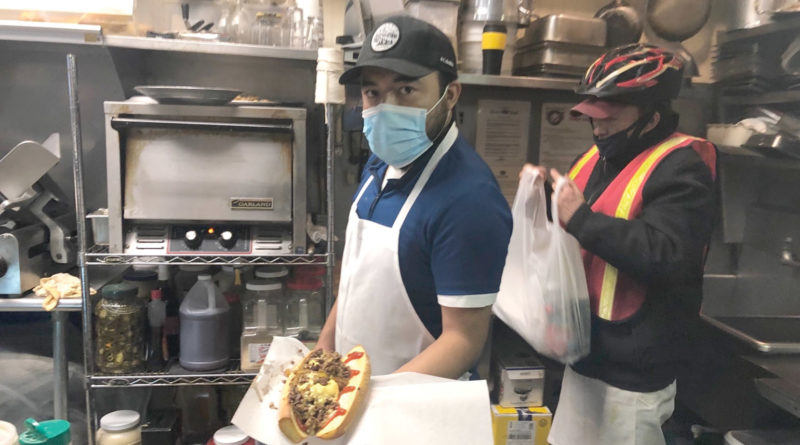Rising Prices Coming for Your Favorite Lunch
ABOVE: Alberta Tendilla poses with a chopped cheese.
BY ANDRE BEGANSKI
Fast-paced New Yorkers like food that is quick, delicious and affordable. Chopped cheese, dollar-priced slices of pizza and breakfast sandwiches are among the common staples of a city diet.
While dollar slices may never budge in price, inflation, labor shortages, and flawed supply chains are pinching small businesses by increasing costs of ingredients used in meals that feed the working class.
In some cases, shops like corner stores and bodegas are forced to pass elevated prices on to the consumer, while other businesses are managing to eat the loss.
“Everything costs a little bit more these days,” said Frank Murro, 57, who owns a small sandwich shop in Queens.
Nestled into a tiny storefront not far from the steps of the 36th Avenue Subway Station in Astoria, Murro opened L&M Italian Deli & Catering in 1988 and has been serving customers ever since.
“Putting them first is the only way I’ve been able to stay open for the last 33 years,” he said.
L&M’s clientele come from all over the city, including local residents, students, and workers in nearby offices, but a majority of them are construction or utility workers.
“Most of these people want the largest portions for as little as possible, but if they eat well, they’ll pay for the quality,” Murro said.
His breakfast sandwiches cost around $5, depending on how they’re ordered. For lunch, L&M offers larger sandwiches on semolina bread and sub rolls stuffed with deli meats and cheeses, alongside quintessential Italian dishes like lasagna or meatballs with pasta for around $10.
“They make it just the way I like it,” said T.J. Themis, 50, holding a warm container of sausage and peppers between both hands. “If people are skimping or cutting corners it will show up in their product, and let me tell you, this store hasn’t skipped a beat.”
While Murro’s profits are suffering because of increased costs on items like fresh produce to paper goods, he’s resistant to the idea of raising prices.
“I waited as long as I could,” he said. “I know it hurts the customer at the end of the day.”
Within the past month, Murro added $1 to the price of sandwiches that contain pastrami or roast beef after seeing the two meats double in price per pound over the past year. He’s nervous items that contain bacon could be the next in line for a markup.
“Some meats disappeared from suppliers’ shelves during COVID, and when they came back, they were way too expensive,” Murros said. “A case of bacon used to run me anywhere from $65 to $80, but now I’m paying at least $100 a case. If I decide to go with Boar’s Head, it’s at least $120.”
Food prices have been rising in the United States throughout 2021, but meat is soaring compared to other foods. Within the past 12 months, the price of bacon has increased nationally by 20 percent, according to the latest Consumer Price Index data from the Bureau of Labor and Statistics.
Meanwhile, beef products are 20.1 percent compared to last year, with the price of pork products up 14.1 percent. Before opening L&M, Murro worked for years as a professional butcher. He believes production in the meat industry has been underwhelming this year for various reasons, but that restrictions around social distancing and limitations to how many people can work on production lines in slaughterhouses is partially to blame.
“Everyone in the meatpacking industry was taking a cautious approach to production last year,” said Arun Sundaram, 30, a senior analyst at the Wall Street firm CFRA Research. “This year demand has improved incredibly, and you have this very imbalanced dynamic between supply and demand in the industry, which is causing meat prices to rice.”
Sundaram described the dynamic as a “lose-lose” situation for shops like L&M and their customers.
“Small businesses, relative to larger retailers, don’t have the purchasing power to buy things at an attractive price,” he said. “Their costs are higher, and they have to pass more of these costs through to the consumer.”
Murro believes some of his regulars, who typically don’t mind spending extra money on eating out, are starting to change their purchasing habits.
“The construction workers with less money are now coming in and buying breakfast twice a day instead of grabbing lunch,” he said. “Some workers said they are dependent on eating out at work because of their busy schedules.”
“At the end of the day, when you’re working away from home, you don’t have a choice but to eat out,” said Chris Lopez, 37, who works in Astoria and frequently orders meatball subs from L&M. “I’m making more lunches at home, but I don’t have time to do it five times a week.”




